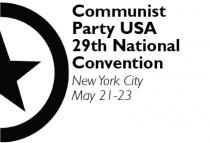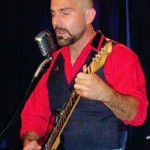 This article is part of the discussion leading up to the Communist Party USA’s 29th National Convention May 21-23, 2010. CPUSA.org takes no responsibility for the opinions expressed in this article or other articles in the pre-convention discussion. All contributions must meet the guidelines for discussion. To read other contributions to this discussion, visit the site of the Pre-Convention Discussion period.
This article is part of the discussion leading up to the Communist Party USA’s 29th National Convention May 21-23, 2010. CPUSA.org takes no responsibility for the opinions expressed in this article or other articles in the pre-convention discussion. All contributions must meet the guidelines for discussion. To read other contributions to this discussion, visit the site of the Pre-Convention Discussion period.
All contributions to the discussion should be sent to discussion2010@cpusa.org for selection not to the individual venues.For more information on the convention or the pre-convention discussion period, you can email convention2010@cpusa.org.
Over its 90 years of existence, the Communist Party USA has had an amazing history, one that spanned the struggles for the rights of workers, African-Americans, women, Latinos and immigrants; one that spoke out fearlessly against war, oppression and capitalism; one that worked tirelessly to fight for a better USA and a better world–one that celebrated the people and refuted the concept of the wealthy few ruling our vast majority. And throughout all of these fights and struggles, the Communist Party has called upon its cultural workers to not only offer social commentary but to inspire the cadre to new heights. More so, the activists who created topical song, theatre, poetry, visual art, film and dance had the unique opportunity to bring the message of social change and solidarity directly to the masses. In a time of intense social upheaval, such as the Great Depression or the Civil Rights era, the arts carried the voice of revolutionary change further and wider than all of the pamphlets and speakers one could find amidst the bustling crowds at a demonstration. The arts have-and continue to-serve the mission well.
Communist Party cultural workers have always been part of organizing and agit-prop efforts and a glance at the incredible list of artists who have fought in the trenches alongside–or as–Party activists speaks volumes. While many of the Party cultural workers were actual members, others were not–needing to avoid the stigma due to professional pressures and a fiendishly reactionary entertainment industry. Such fellow travelers took a stand within their actions, writings, performances, which all served as a new and often global kind of widespread outreach. Giants like Paul Robeson, Woody Guthrie, Howard Fast, Mike Gold, Meridel LeSeuer, Pete Seeger, Aaron Copland, John Howard Lawson, Tillie Olsen, Charles Lewis Seeger, and an endless supply of others, in and out of organizations like the John Reed Clubs, the Almanac Singers, the Theatre Union, the New Theatre, the Composers Collective of New York, the Red Dancers, the Workers Film and Photo League and on and on. Some of these organizations, and organs like the New Masses, Partisan Review and a bevy of smaller, short-lived titles, reached out directly to a socially conscious public, while others were designed specifically for inner Party functions. These varying levels of activism–some on the front lines of political and social action, others further back and acting as a means of commentary and awareness–allowed Party cultural workers to have a powerful voice in serious activism…and a means toward the ultimate goal of socialism.
Party cultural programming grew with the Party; it was born of the two of the founders of the twin communist organizations that begat the current CPUSA: John Reed and Louis Fraina. Reed, the celebrated journalist in great demand by the bourgeois press and Fraina the working-class writer who’d been published in both socialist and arts periodicals, served to flank the fledgling Party with a basis not only in the revolutionary but the artistic. The Party, in the Leninist mode, solicited the good work of protest artists in all genres and the writers were often interwoven closest to Party leadership. While cultural workers would like to think that their brethren were always in high esteem by the National Board, this was not always so; as is expected, political theorists and activists do not always understand the visceral place of the arts. Yet, the cultural leaders in the Party maintained a level of importance in both leadership and in outreach efforts. Ultimately, the Communist Party could count a wealth of important members among the film artists of Hollywood, the writers, theatre artists and musicians in New York, and a series of brilliant regional cultural workers throughout the country.
The Cold War years, which saw a dramatic decline in Party membership, also saw a great dip in the actions of Party cultural workers. HUAC and its similarly opportunistic and vindictive Senate counter-part saw many Party artists running for cover. With this, Party leadership began to accept a smaller place for cultural programming. While trying to fight off litigation, blacklisting and intense political and social pressures, the CP national leadership were unable to support such cultural efforts and apparently failed to see the power in artistic communication. This problem, thought shifting a bit up and down over the decades, remains with us.
With this, the 90th anniversary of the Communist Party, I state unequivocally that the Party needs to take a closer look at not only its history of cultural programming, the work of artistic leaders such as Mike Gold and VJ Jerome, but further back to the Party’s roots. The two organizations which begat our current Communist Party USA counted two powerful cultural workers among it’s earliest founders…and what better way to celebrate this Party than by taking note of its cultural heritage. I have proposed for months now that a cultural discussion should be paramount in the line-up for this coming convention. And during this discussion that a Cultural Commission be adopted without question. In a climate of reactionaries desperately seeking out the evils of “socialism” and “Marxism” in the Obama Administration, its of great importance that we speak directly to the American public-and to do so effectively we need to make full use of the artists of conscience. The word of such dedicated cultural workers is by far the most visceral communication there is. It speaks directly to us all via the colors of the visual, the pulsations of rhythm, the soaring of melody, the power of drama, the wonder of literature and the vastness of movement. It speaks from the heart, the mind and the soul. Art is a weapon-an important one-and needs to be part of our revolutionary political and social change.


 Join Now
Join Now